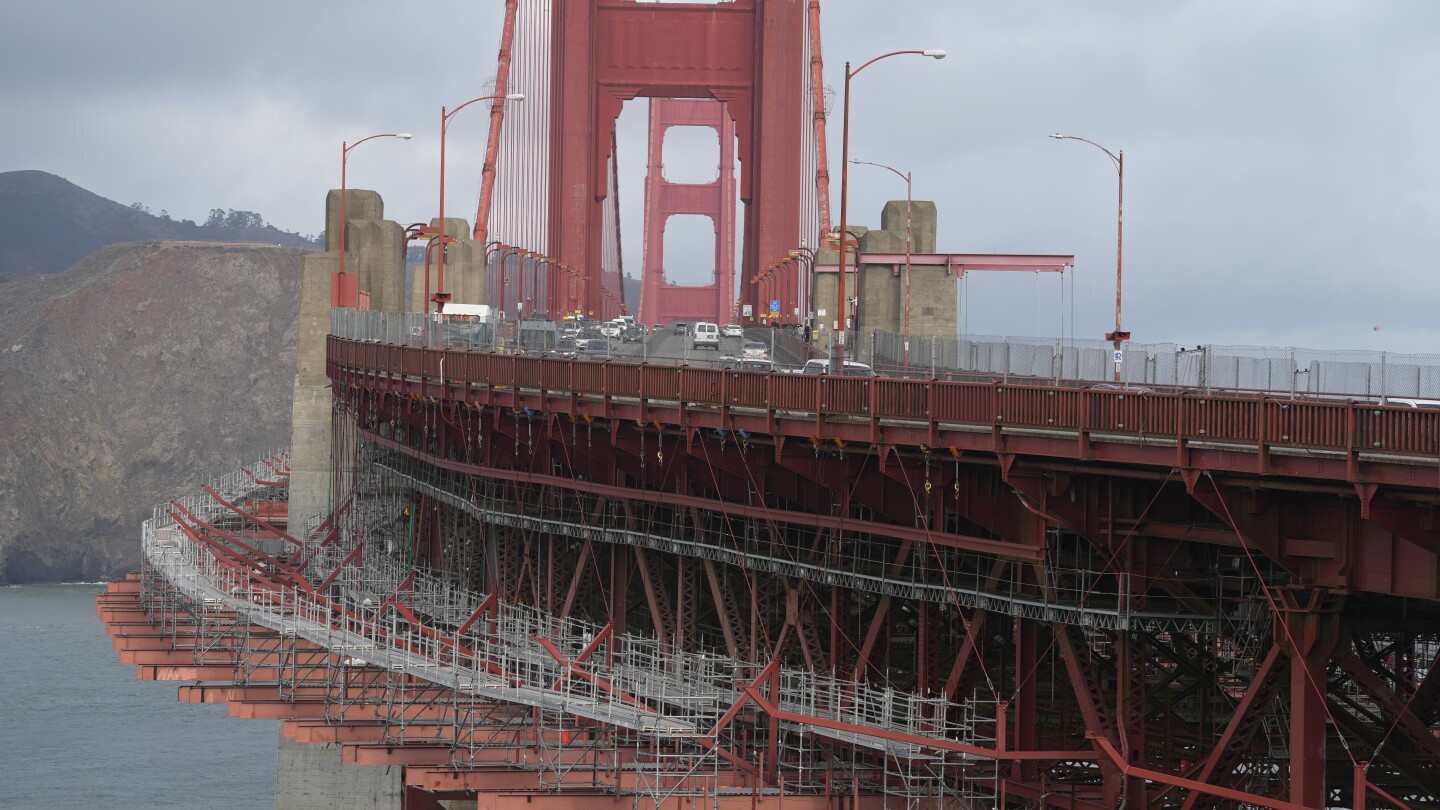Kevin Hines regretted jumping off San Francisco’s Golden Gate Bridge the moment his hands released the rail and he plunged the equivalent of 25 stories into the Pacific Ocean, breaking his back.
Hines miraculously survived his suicide attempt at age 19 in September 2000 as he struggled with bipolar disorder, one of about 40 people who survived after jumping off the bridge.
Hines, his father, and a group of parents who lost their children to suicide at the bridge relentlessly advocated for a solution for two decades, meeting resistance from people who did not want to alter the iconic landmark with its sweeping views of the Pacific Ocean and San Francisco Bay.
On Wednesday, they finally got their wish when officials announced that crews have installed stainless-steel nets on both sides of the 1.7-mile (2.7-kilometer) bridge.
“Had the net been there, I would have been stopped by the police and gotten the help I needed immediately and never broken my back, never shattered three vertebrae, and never been on this path I was on,” said Hines, now a suicide prevention advocate. “I’m so grateful that a small group of like-minded people never gave up on something so important.”
Nearly 2,000 people have plunged to their deaths since the bridge opened in 1937.
City officials approved the project more than a decade ago, and in 2018 work began on the 20-foot-wide (6-meter-wide) stainless steel mesh nets. But the efforts to complete them were repeatedly delayed until now.
The nets — placed 20 feet (6 meters) down from the bridge’s deck — are not visible from cars crossing the bridge. But pedestrians standing by the rails can see them. They were built with marine-grade stainless steel that can withstand the harsh environment that includes salt water, fog and strong winds that often envelop the striking orange structure at the mouth of the San Francisco Bay.



So, now you just need to jump from the net after it catches you? That does not seem like much of a barrier.
every barrier helps, most suicide attempts are impulse decisions. forcing people to jump 30 feet into a net before they can jump a lethal distance makes it that much harder to follow through.
100%.
Source
But is it saving anyone or are they jumping from somewhere else?
Probably a bit of both. “Successful” suicide and following through with ideation is partly about opportunity. This is why likelihood of suicide is higher in homes with firearms, especially handguns, that are easy to access. Making following through with a suicidal impulse or ideation mitigates the situation for long enough for a good portion of people to shake it and/or get help.
There are still those that will seek out another way but, by mitigating the risk at the Golden Gate, resources that have been needed there can be partially re-allocated to other spaces to catch those that are still slipping through. In a sense, it’s a bit like triage and whack-a-mole, where the population at the next target is likely smaller.
Not an impulse decision. It’s been what I’ve wanted for the past couple years. When I tried, my finger wouldn’t pull the trigger just like Dolores couldn’t do it at first in Westworld.
I think it’s more “successful suicide” is generally an impulse decision because that disallows our self-preservation time to kick in.
That said, are you ok? Need someone to talk to? Why have you desired to end your life?
I’m not a qualified mental health professional but would be willing to lend a virtual ear, if you need it, and see if I can help to find resources available to you. I’m not going to be terribly available today but please feel free to DM me.
Self preservation is an impulse.
Think of the first fall as a “proof of concept”. If after falling ~20 feet to a chain link fence, you still feel like dragging your injured self to the edge of the fence to finish the job, then it’s highly unlikely anything will stop you from killing yourself. The fence is kind of a “try before you buy” thing.
Pain is not death. False advertising.
A 20’ drop to a steel rope net wouldn’t be a soft landing. It’s unlikely anyone would be able to, or be interested in, crawling to edge to finish the job.
Oh so you injure the person and laden them with medical debt, America really is great >:)
They injure themselves.
Lol, what is up with this comment chain?
News posts regarding suicides turns depressed lurkers into commenters.
Probably because the “services” that are “designed to help us” usually involve throwing us in a psych ward where you’re surrounded by people with serious mental illness to the point you can’t sleep a full night because some guy down the hall is screaming at the demons in his head.
So yeah that could be a reason.
They injure themselves? What are you trying to say?
They injure themselves because they are the ones who choose to jump…
So why not just let them choose death?
This is still going to hurt a lot of people that jump, probably still broken backs and the occasional death.
This is one of those “clever” comments that are actually just retarded if you think about it.
Did you read the article? One guy who jumped said he regretted it immediately after falling. This gives people an opportunity to experience that same regret before they try doing it again.
I too would regret suicide when asked especially because if I say ‘Im gonna do it again’. - I get to spend 3 more days on a psychiatric hold treated like an animal.
Are you trying to argue that most people who regret suicide attempts are lying about it to avoid treatment?
As someone who has worked in medicine, saying you want to die is a surefire way to have all your medical autonomy taken away.
Yes.
Have you ever been Baker Acted? Met anyone Baker Acted?
It’s one of the most dehumanizing things you can do to a person, and then they get a bill for $5,000 for treatment.
There are an absolute fuck ton of people who lie about suicidal ideation because they fear the consequences of being honest. So why do you think after being rescued, and forced into a hold - that they would then be honest?
Do you know what proportion of people who regret suicide attempts are lying about it?
deleted by creator
Oh, so you don’t know if it’s 5% or 50%?
Well, whatever the percentage may be, consider the remaining people who do regret it afterwards and aren’t lying about it.
deleted by creator
I’m from Melbourne. We had a problem with people jumping from the West Gate bridge and we engineered safety barriers that reduced suicides to zero.
That’s right. Zero.
It even reduced the jump rate by 65% at our other bridges. All that, without looking cheap and ugly AF.
Photo of bridge
All that and The Golden Gate Bridge is still way better looking. It’s not even close.
Did it actually reduce suicides though, or just redirect them to other means?